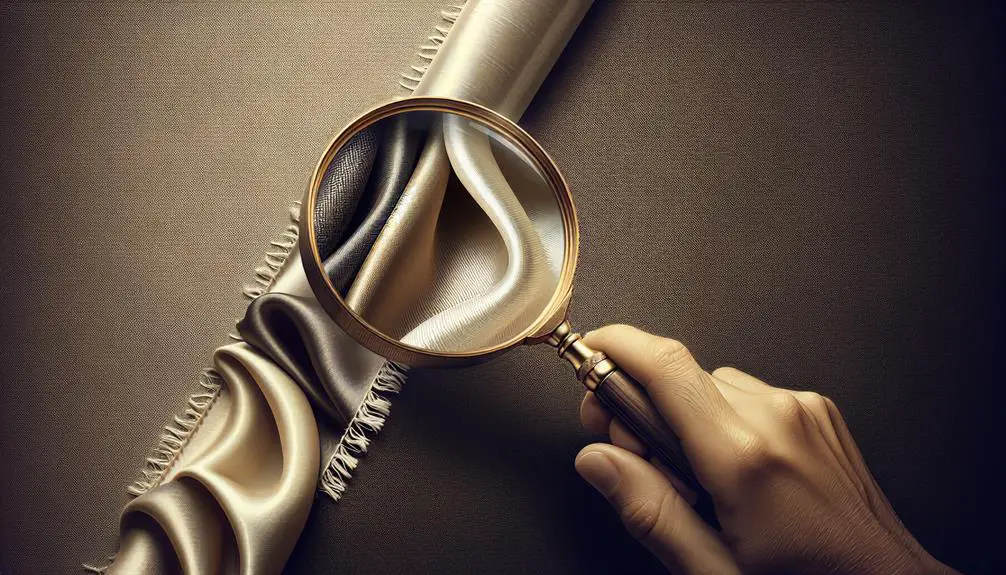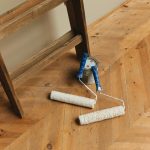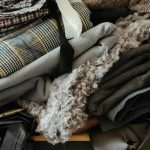Ever found yourself puzzled, trying to figure out if that satin piece in your closet is the real deal or just a clever imitation? I've been there, and let me tell you, it's not as straightforward as it seems. You've got to look beyond the shiny surface. The feel of the fabric, the look of the weave, and yes, even the smell when it burns, all give away clues. But here's the kicker: there are a few simple tricks that can help you spot the difference in no time. Stick around, and I'll share some insider tips that could save you from another faux pas.
Table of Contents
Key Takeaways
- Check the fabric label for terms like 'synthetic', 'polyester', or 'acetate' to identify synthetic satin.
- Perform a burn test: real satin melts and produces a chemical smell, unlike silk.
- Look for a smooth, glossy front and a dull back, indicative of satin's weaving technique.
- Test with water droplets; they should sit on top of genuine satin due to its tight weave.
- Observe the fabric's reaction to light; real satin has a reflective shine that enhances its opulence.
Understanding Satin Composition
To really get what satin's all about, we've gotta dive into what it's made from and how it's put together. Unlike silk, which is a natural fiber, satin is all about the weave. This fabric can be whipped up from polyester, acetate, or nylon, giving it that glossy look we all love. Now, don't get it twisted; just because it's often made from synthetic stuff doesn't mean it's any less luxe to the touch or easy on the eyes.
Satin's secret sauce is in its weaving technique. This method is what gives satin that smooth, shiny front that catches the light just right, and a duller back. It's a clever trick of the trade that turns otherwise ordinary materials into something that feels a bit more special. Plus, because it's typically not made from silk, it's not only easier on your wallet but also on your laundry routine. Authentic satin shines, literally and figuratively, thanks to this unique combo of synthetic fibers and weaving wizardry. So, when you're eyeing that glossy fabric, you're looking at a piece of human ingenuity as much as a style statement.
Texture and Feel Analysis
Diving into the texture and feel, real satin's smooth and slippery surface sets it apart from the cozy softness of genuine silk. When I first got my hands on a piece of real satin, I noticed right away it didn't have that warm, inviting touch that silk fabric offers. Instead, satin feels cool and somehow less welcoming, lacking the natural luster and warmth that comes with silk.
To really get a grip on what you're dealing with, consider these points:
- Synthetic Feel: Satin's synthetic nature, usually polyester, gives it a distinct feel that can sometimes seem plasticky or artificial. This is a stark contrast to silk's luxurious, natural softness.
- Breathability: Unlike silk, satin doesn't offer much in terms of breathability or thermoregulating properties. This difference in texture and feel is a dead giveaway.
- Burn Test: If you're still unsure, a burn test can reveal the truth. Silk burns clean and smells like burnt hair, while synthetic silk (satin) melts and smells like burning plastic.
Understanding these differences has been key for me in distinguishing between real satin and genuine silk fabric. It's all about paying attention to the details.
Reflectivity and Shine Test
After exploring the texture and feel, let's focus on how real satin's smooth, glossy finish gives it that signature reflective shine. This shine test is crucial for distinguishing real silk vs synthetic imitations. Real satin, with its high-quality materials and weave structure, not only feels luxurious but also has a unique way of reflecting light that sets it apart. It's all about the reflectivity and the soft, sophisticated shine that enhances its opulence.
Here's a quick guide to help you master the shine test:
| Feature | Real Satin vs Synthetic |
|---|---|
| Shine | Soft, sophisticated |
| Reflectivity | Uniform, luminous |
| Light Reflection | Elegant, enhances luxury |
| Appearance | Glossy, smooth finish |
Real satin's authentic shine is subtle yet distinct, unlike the often harsh, glaring shine of synthetics. Its ability to reflect light uniformly across its surface creates a luminous effect that's hard to replicate. So, when you're trying to figure out if your fabric is the real deal, remember, the shine test reveals a lot about the quality and authenticity of satin. It's not just about how it looks, but how it interacts with light.
Checking the Fabric Label
Let's take a closer look at why reading the fabric label is your next best step in confirming if your satin is the real silk deal. Now, I get it, we're all about finding that genuine silk goodness, and frankly, the label's where the truth lies. Here's the scoop:
- Seek the Magic Words: Look for labels that shout out '100% silk' or 'pure silk.' This is your golden ticket. Anything less, and you might be holding a wannabe in your hands.
- Beware of Imposters: Keep an eagle eye for terms like 'synthetic' or 'polyester.' These are the red flags waving you away from fake satin territory. Trust me, you don't want to go there.
- Special Mentions Matter: Sometimes, you'll come across 'silk satin' or 'pure mulberry silk' on the tag. That's the good stuff, signaling you've hit the genuine silk jackpot.
In mastering the art of identifying real silk satin, the fabric label is your best friend. It cuts through the noise, offering a beacon of truth in a sea of imitations. Remember, if it doesn't say silk, it's time to walk away.
The Burn Test Method
Moving on to the burn test method, it's a surefire way to spot the real deal from the fakes when it comes to satin. Now, this might sound a bit out there, but hear me out. If you're holding a piece of satin and wondering if it's genuine or not, the burn test is your go-to. Here's the scoop: synthetic satin, which is usually made from polyester, behaves pretty differently under fire compared to natural fibers like silk.
When you light it up, synthetic satin melts and gives off a chemical smell, a dead giveaway it's not natural. And instead of leaving ashes like you'd expect with natural materials, it forms hard beads. That's your clue. On the flip side, silk, a natural fiber, burns differently. It smells kinda like burning hair and doesn't melt but rather burns more cleanly.
What's more, satin's synthetic nature means it catches fire quickly but often the flames die down as soon as you remove the heat source. So, if you're testing, that's another thing to watch for. This whole burn test is a solid method to tell if you've got real satin or a clever imposter.
Price Comparison Insights
Let's talk about how price can clue us in on whether we're looking at real satin or not.
You'll find that the cost versus quality debate is pretty telling; genuine satin won't break the bank compared to silk.
Plus, market price variability and certain authenticity indicators are key to making sure you're getting the real deal.
Cost Versus Quality
When it comes down to choosing between real satin and silk, the price tag often tips the scales in satin's favor. Here's the deal:
- Satin fabric is simply less expensive to produce than silk. We're talking materials and manufacturing processes that don't break the bank.
- Despite its lower cost, quality satin doesn't skimp on that luxurious feel and shiny appearance we all love. It's like getting the glam without the guilt of overspending.
- Between the cost versus quality debate, satin's affordability makes it a no-brainer for anyone wanting that sleek look without forking over a fortune for silk.
In essence, while silk holds a high-end allure, satin delivers a similar vibe for a fraction of the price. It's all about smart shopping, folks.
Market Price Variability
Having covered how satin offers luxury for less, it's worth exploring how market price variability gives us further insights into recognizing real satin.
Genuine satin, being cheaper to produce than silk, usually hits the market at a lower price point, thanks to its synthetic makeup. This price variability between satin and silk can be a dead giveaway. If you're eyeing a satin product and its price seems too good to be true, especially when compared to silk items, take a pause.
That significant price gap isn't just about brand markup; it's rooted in the material's authenticity. Price variability, then, isn't just about finding a bargain—it's a crucial clue in spotting the real deal in a sea of satin.
Authenticity Indicators
Price comparison shines a light on the real satin, revealing its more affordable nature without compromising on luxury. When we dive into the nitty-gritty of satin fabric, a few things stand out:
- Silk vs. Satin Price: Genuine satin is typically less expensive than silk, making it a go-to for those who love the silk feel without the hefty price tag.
- Quality Levels: Despite its lower cost, high-quality satin can still mimic the luxurious look and feel of silk, all thanks to its synthetic composition.
- Burn Test: When in doubt, a quick burn test can help identify real satin; it behaves differently compared to silk when exposed to flame.
Understanding these aspects ensures you're getting the real deal without breaking the bank.
Color and Dye Behavior
Moving on, let's chat about how real satin behaves with color and dye.
I've noticed it doesn't fade like the fake stuff does, and how it absorbs dye can tell you a lot about its quality.
Plus, looking at how the colors change under different lights can be pretty telling.
Dye Absorption Rate
The dye absorption rate of real satin is pretty low, meaning it keeps its vibrant colors for ages without fading or bleeding. This is a big deal if you're into fabrics that look as good as new, even after several washes. Here's why real satin, especially when we're talking silk fiber, stands out:
- Silk Fiber Quality: Silk, the usual suspect in genuine satin, naturally resists color bleeding. Its tight weave means colors stay put.
- Minimal Transfer: Even when you get it wet or rub it against something, the dye doesn't jump ship easily.
- Burn Test Insights: This might sound off-track, but conducting a burn test can show you how the fabric interacts with heat, indirectly hinting at its dye absorption rate.
Spotting the real deal means paying attention to these subtle signs.
Fading Patterns Analysis
Analyzing fading patterns, it's clear that real satin's color and dye behavior is top-notch, resisting changes even after multiple washes. When you're dealing with genuine satin, especially if it's quality silk, you're in for a treat. This stuff doesn't just give up its vibrant colors and sheen over time. Nope, it holds onto them like a treasure.
And let's not even start on how evenly the dye penetrates the fibers. You won't see any of that patchy or uneven color distribution that cheaper fabrics often show off. Plus, real satin's deep colors don't fade or wash out easily. It's like they're locked in there.
If you're ever in doubt, remember the burn test can be a telltale sign of quality silk.
Water Absorption Test
Let's dive right into a simple trick to spot real satin: the water absorption test. You're probably wondering how a little water can help identify real satin, especially when we're talking about silk, one of the most luxurious fabrics out there. Well, it's all about how the fabric interacts with water.
Here's how to do it:
- Place a Small Drop of Water: Start by putting a tiny amount of water directly on the surface of the fabric you suspect to be satin.
- Observe the Reaction: Genuine satin will have the water droplet sitting on top for a bit without being absorbed right away. This happens because real satin, with its tightly woven structure, repels water, causing it to bead up.
- Assess the Outcome: If the water droplet is quickly absorbed, then what you have is likely not authentic satin.
This water absorption test is a neat trick to differentiate between real satin and other fabrics pretending to be it. Real satin's ability to repel water, thanks to its tight weave, is what sets it apart in this test.
Weave and Thread Count
Next up, let's talk about what makes the weave and thread count so key in spotting the real deal.
I've found that the shine and feel of satin largely come down to its high thread count and unique satin weave.
This combo not only gives it that luxurious touch but also sets it apart from the knock-offs.
Identifying Weave Patterns
Diving into the heart of what makes real satin stand out, it's crucial to understand the weave patterns and thread count that define its luxurious essence. Here's how you can spot the real deal:
- Satin Weave Pattern: Look for the satin weave's hallmark—a glossy front and a dull back. This unique structure, featuring long floating yarns, gives satin its smooth, shiny surface.
- Thread Count: Genuine satin boasts a high thread count, contributing to its soft, silky texture and subtle sheen. This is something you can't overlook if you're after the authentic experience.
- Silk Identification: When it comes to identifying silk satin, a burn test can be telling, but let's save that for another discussion.
Analyzing Thread Density
Peering into the intricacies of thread density can unlock the secrets behind a fabric's luxurious feel and durability, especially when we're talking about satin. Real satin's got a thread count that's through the roof, think at least 300 threads per square inch. That's what gives it that plush vibe.
Dive into the weave, and you'll see it's not your average pattern. We're looking at complex structures like charmeuse, making silk satin feel as smooth as it does. The tighter the weave, the smoother and more durable the satin. It's all about that glossy finish that catches the light just right, something synthetics can hardly mimic.
To spot the real deal, always check the thread count and weave. If it's legit, it'll not only look the part but burn like silk too.
Comparing Satin and Silk
When comparing satin and silk, it's clear they differ significantly in both texture and quality. Let's dive into the essentials, focusing on the natural allure of silk against the often synthetic makeup of satin. Here's what sets them apart:
- Composition: Silk is a natural protein fiber, making it exceptionally smooth and soft. This natural origin contributes to its luxurious feel. On the other hand, satin is typically made from polyester, which can sometimes give it a cheaper, synthetic texture that just doesn't compare.
- Feel and Performance: Silk not only feels smoother than satin; it also offers breathability and thermoregulating properties, making it a dream for both hot and cold sleepers. Satin, lacking these natural properties, can't quite match up in terms of comfort and adaptability.
- Authenticity and Prestige: Silk's unique properties make it harder to replicate, adding to its authenticity. It's often labeled as pure mulberry silk, a mark of its luxury and historical prestige. Satin, lacking these distinctions, can't boast the same level of exclusivity.
Professional Authentication Tips
To spot real satin, it's smart to get a pro's opinion on its key traits like sheen and texture. I've learned that nothing beats the eye of someone who really knows their stuff when it comes to fabrics. These experts can tell if silk is real by just a glance at how it catches the light or by feeling its weight in their hands.
They dive deep into the nitty-gritty, examining the fabric under different lighting to see that signature glossy appearance and luxurious feel that screams authentic satin. It's not just about looking good; it's about confirming the fabric's pedigree. And trust me, these pros don't mess around. They're like detectives, using their knowledge of the production process and material composition to separate the real deal from the imposters.
I've also heard them talk about the burn test, though that's a bit too hardcore for my tastes. But it's all part of the professional authentication magic. They've got this uncanny ability to provide insights that go beyond what the average Joe, like myself, can perceive. So, when in doubt, I always say it's worth getting that professional authentication. It's the surefire way to know you're investing in the real satin experience.
Caring for Real Satin
Maintaining the luxurious look and feel of real satin means giving it the tender loving care it deserves. As someone who's all about keeping that gorgeous silk fabric in top-notch condition, I've learned a thing or two about the right way to care for it. Here's the lowdown:
- Washing Techniques: Always opt for hand washing or a gentle cycle in the washing machine. Real satin's not a fan of rough handling, so I make sure to treat it with the softness it commands. Harsh chemicals or bleach? Not in my house. They're a big no-no since they can seriously damage the fabric's delicate structure.
- Drying Methods: After washing, I hang-dry my satin to avoid any unnecessary wear and tear. If I'm in a hurry, a low-heat setting on the dryer does the trick, but I'm careful to not overdo it. Keeping the heat too high is like inviting trouble.
- Ironing Tips: Low heat is the way to go when ironing satin. I always use a cloth barrier between the iron and the fabric. This little hack prevents any direct contact that might harm the fabric's surface.
Caring for real satin isn't rocket science, but it does require a bit of attention to detail. Trust me, it's worth it to keep that silk looking as stunning as the day I bought it.
Frequently Asked Questions
How Can You Tell if Something Is Real Satin?
I usually check the label for "100% silk satin" or "pure silk satin" and feel its texture. Real satin's cool, smooth touch and elegant drape are dead giveaways compared to synthetic versions.
What Does Real Satin Look Like?
I've noticed real satin has a glossy front and a matte back. It's smooth, drapes well, and feels cool and soft. It's about looking for that luxurious sheen and elegant drape to spot it.
How Do You Test Satin Fabric?
I usually test satin by checking the label for materials and feeling the texture. If that's inconclusive, I'll do a burn test. Real satin smells like burnt hair, while fake satin smells like melting plastic.
How Can You Tell Satin?
I usually check the label for silk content and feel the fabric's surface. If it's smooth with a glossy finish and drapes well, it's likely real satin. Price can also be a big indicator.
- A Buyer’s Guide to Acetate Fabric: Where to Find It and What to Look For - June 24, 2025
- Understanding Acetate Lining Fabric: Properties, Uses, and Care - June 24, 2025
- Is Acetate Fabric Stretchy? What to Know Before You Sew or Buy - June 24, 2025






